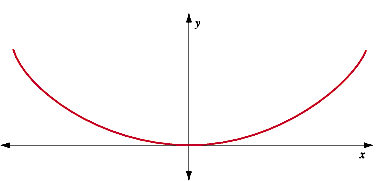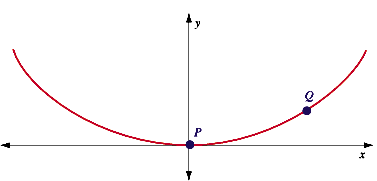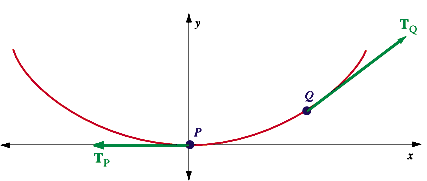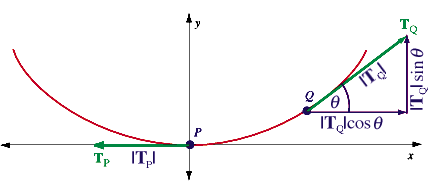Initial Value Problem Applications - A Suspended Wire
Applications of Differential Equations
A Suspended Wire
Theoretical Introduction
The problem we're about to tackle is that of finding the mathematical equation which describes the shape of a hanging cable, such as a telephone wire hanging between telephone poles, or an electrical cable suspended between pylons. It may seem at first that the solution is obvious--after all, the shape formed looks very much like a parabola. Sadly our instincts lead us astray in making this assumption! Perhaps even more surprising than this is the fact that the derivation of the correct formula involves the use of differential equations.
Setting up the Mathematical Model  Interactive Wire
Interactive Wire
So let's begin the mathematical derivation. Before we can even think about getting a formula describing the shape in question we need to impose some kind of coordinate system on the problem in order to put it into a mathematical context. Perhaps the easiest choice we could make is to impose a Cartesian coordinate system over the profile of the wire such that the lowest point on the wire passes through the origin of the system, as shown here:

Now let's concentrate on a small segment of the wire, and analyze the forces that this segment is experiencing. For ease of analysis, let's consider a short section that stretches from the origin to a point on the wire somewhere in the first quadrant. We'll refer to the two end points as P and Q. So now we have a picture that looks like this:

A Little Physics
We're going to need just a little physics at this point, because we're now going to look at the tension experienced by the wire at the two end points, P and Q, of our segment of interest. I think you'll agree that the tension at each point can be thought of as a vector whose direction is tangent to the curve of the wire, and pointed away from the segment. If we call these two tension vectors TP and TQ then our picture becomes:

OK, now a little more physics. Since the wire is in an equilibrium state, (it isn't moving), then we can conclude that the forces acting on the wire are in equilibrium themselves. (If they weren't there would be an overall non-zero force acting on the wire in some direction, which should result in acceleration, according to Newton's second law of motion.) So, all forces involved here are balanced by other, equal and opposite forces. At this point then, it may pay us to start breaking down the vectors in our picture into their individual horizontal and vertical components, then use the "balanced" nature of the forces to produce some equations that may be useful.
Decomposing the Tension Vectors
TP is obviously 100% horizontal component, i.e. it's vertical component is zero, so we only need to bother with decomposing TQ. This decomposition may be seen in the picture below, where the triangle on the right has legs whose lengths are the horizontal and vertical components of TQ that we seek.

Note that in order to discuss the decomposition of vectors it is necessary to have their magnitudes, (their lengths.) These I have denoted in the picture by using absolute values around the vector name, i.e. |TP| is the length, or magnitude of TP, and |TQ| is the length, or magnitude of TQ.
Note also that it only takes a small amount of simple, right triangle trigonometry to label the horizontal and vertical components of TQ once the angle and hypotenuse of the triangle have been labeled.
Equating The Magnitudes of Opposite Components
Now, we said earlier that all forces within the cable are balanced by equal and opposite forces, resulting in the cable's equilibrium state. This means that:
the horizontal components of TP and TQ are equal and opposite.
But what about their vertical components? Well, obviously the vertical component of TP is zero. So what force could possibly be balancing the upward vertical component that TQ clearly exhibits? Haven't we been forgetting another force that the cable must be experiencing, a force other than tension? Haven't we overlooked the force of gravity acting on the cable's mass, i.e. the weight of the cable?
Once we take the cable weight into consideration we have that:
the vertical component of TQ and cable segment PQ's weight are equal and opposite.
So let's make a check list of the quantities we need in order to take advantage of the equality of components we mentioned above:
Magnitudes of Horizontal Components
- To the left: we have a force of magnitude |TP|.
- To the right: we have a force of magnitude |TQ| cos θ.
Magnitudes of Vertical Components
- Upwards: we have a force of magnitude |TQ| sin θ.
- Downwards: we have a force equal to the weight of the cable. Unfortunately, "the weight of the cable" isn't specific enough to be very useful in setting up the equations we'll need, so let's do a little more analysis.
Say that the cable is of constant thickness and density, (which is not a very strange assumption when you think about it.) If this is the case then we can talk about the cable's linear weight density measured in, say, newtons/meter. Let's say that the cable in question has a linear weight density of w n/m.
Now, say that the length of the cable from P to Q is s meters. Putting this together with the fact that the cable weighs w newtons/meter, we get that the entire segment of cable under consideration has a weight of w s newtons. Conclusion:
Downwards: we have a force of magnitude w s.
So let's get back to equating the magnitudes of the corresponding components.
Horizontally, we have:
magnitude of the force to the left = magnitude of force to the right
or, in symbols:
|TP| = |TQ| cos θ
Vertically, we have:
magnitude of the force upwards = magnitude of force downwards
or, in symbols:
|TQ| sin θ = w s
which could also be written as:
w s = |TQ| sin θ
Deriving the s-θ Relationship
At last! Mathematical equations that we can manipulate! Now we're going to combine these two equations to our advantage. Notice how both:
w s = |TQ| sin θ
and:
|TP| = |TQ| cos θ
have |TQ| on the right hand side. (That's why I traded sides a couple of steps back!)
This means that if we divide the first by the second we get:
(w s) / |TP| = (|TQ| sin θ) / (|TQ| cos θ)
Canceling the |TQ|'s on the right hand side, and combining the sine and cosine to give a tangent function we get the simpler equation:
(w s) / |TP| = tan θ
We must now ask ourselves whether this is the equation we were looking for. We started out to find an equation for the curve formed by a hanging cable. In our very first graph we superimposed the cable on an xy-coordinate system, so it would only be natural to expect our final equation to express a relationship between the variables x and y. A glance at the equation we just derived reveals a relationship between the variables θ and s. (Note that w and |TP| are constants.)
I suppose we could leave the equation like this, but it wouldn't be very useful. So, our quest for an xy-equation continues.
Deriving the x-y Relationship
We now need to get x into the picture, (not to mention y,) and get rid of θ and s.
Eliminating s
Let's designate the coordinates of point Q as (x,y). This means that as the cable stretches from P to Q it actually stretches between coordinates (0,0) and (x,y). A quick dig in your memory banks should help you to recall that there is a way of calculating the distance along a curve between two known x-values.
In your second calculus course you should have learned the following formula for the length, L, of a curve between x = a and x = b:

In our particular case the curve length has been designated as s and the points we are measuring between are (0,0) and (x,y). Putting these quantities into the above equation we get:

So we've managed to get a way of transforming s into x's and y's. But we still have a problem--the formula we just found involves an integral. Using it in this form will lead us to an integral equation , not a differential equation. (There are courses devoted to integral equations, but this course isn't one of them.) How could we get rid of the integral?
The obvious answer is to use the fundamental theorem of calculus, (well, at least one of its flavors,) which states that differentiating an integral (under the right conditions) kills the integral. So applying the derivative with respect to x to both sides of the last equation gives us:

which condenses to:

This now contains no integral, but we unfortunately have the derivative of s, rather than just plain s. We'll tackle this issue in a while. First we'll look at replacing the other unwanted variable in our equation—θ.
Eliminating θ
Remember that the equation we're trying to "fix up" is:
(w s) / |TP| = tan θ
So far we have the s (kind of) taken care of. The θ still remains. The trick here is to not concentrate on θ alone, but to consider tan θ as a whole. If you look back to the earlier diagrams, you should note that tan θ is actually the slope of the tension vector TQ. (If can't see this think tan θ = opp/adj = rise/run = slope.)
But another way of thinking of the slope of the tension vector TQ is to remember that it lies tangent to the curve of the cable. You learned at the very beginning of your calculus course that the slope of a tangent line is given by the derivative.
To summarize, then, we have:
slope of TQ = tan θ
and we also have:
slope of TQ = dy/dx
Putting these two together gives us:
tan θ = dy/dx
At last we have a way of replacing the θ in the equation of the cable.
Putting it all Together
Once again, remember that the equation of the cable, as we have it so far is:
(w s) / |TP| = tan θ
We can immediately replace the tan θ by dy/dx, according to the work we just completed. This makes the cable's equation become:
(w s) / |TP| = dy/dx
or, flipping it around:
dy/dx = (w s) / |TP|
But the s still needs to be dealt with! A little earlier we found that:

If we only had ds/dx in our cable equation, instead of just s, we'd be all set. But wait! There's nothing to stop us from producing the derivative for ourselves. Let's just take the derivative of both sides of of the cable equation:
dy/dx = (w s) / |TP|
to get:

which can now be substituted into the curve length equation to get:

Whew! That's it! We got it! An equation for the hanging cable which uses only the variables x and y. As promised, it's a differential equation. Worse yet, it's a second-order non-linear differential equation, which, you may have learned in class already, makes it much harder to solve. We'd really like to solve it since we'd like to see a final formula for the hanging cable in the form y = f(x).
Thankfully we'll be having the computer help us with this last part of the problem. It's now time to go to Mathematica, and get on with the job!







